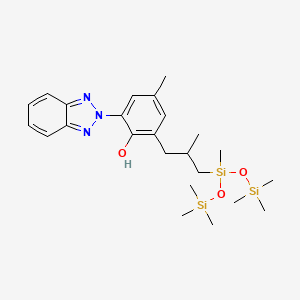

1. Mexoryl Xl
2. Silatrizole
1. 155633-54-8
2. Silatrizole
3. Mexoryl Xl
4. Drometrizole Trisiloxane [inci]
5. Drometrizole Trisiloxane [who-dd]
6. 2-(benzotriazol-2-yl)-4-methyl-6-[2-methyl-3-[methyl-bis(trimethylsilyloxy)silyl]propyl]phenol
7. Or 10154
8. Or-10154
9. Hc22845i1x
10. Phenol, 2-(2h-benzotriazol-2-yl)-4-methyl-6-(2-methyl-3-(1,3,3,3-tetramethyl-1-((trimethylsilyl)oxy)-1-disiloxanyl)propyl)-
11. Phenol, 2-(2h-benzotriazol-2-yl)-4-methyl-6-(2-methyl-3-(1,3,3,3-tetramethyl-1-((trimethylsilyl)oxy)disiloxanyl)propyl)-
12. 2-(2h-benzo[d][1,2,3]triazol-2-yl)-6-(3-(1,1,1,3,5,5,5-heptamethyltrisiloxan-3-yl)-2-methylpropyl)-4-methylphenol
13. Phenol, 2-(2h-benzotriazol-2-yl)-4-methyl-6-[2-methyl-3-[1,3,3,3-tetramethyl-1-[(trimethylsilyl)oxy]-1-disiloxanyl]propyl]-
14. Unii-hc22845i1x
15. Mexoryl Xl;silatrizole
16. Schembl15380
17. Amy224
18. Dtxsid40431753
19. Act12435
20. Bcp28866
21. Db11585
22. Drometrizole Trisiloxane [usp-rs]
23. Ncgc00532508-01
24. Db-091411
25. Drometrizole Trisiloxane, Analytical Standard
26. Q5308268
27. Drometrizole Trisiloxane, United States Pharmacopeia (usp) Reference Standard
28. 2-(2h-benzotriazol-2-yl)-4-methyl-6-(2-methyl-3-(1,3,3,3-tetramethyl-1-(trimethylsilyloxy)-disiloxanyl)propyl)phenol
29. 320341-73-9
| Molecular Weight | 501.8 g/mol |
|---|---|
| Molecular Formula | C24H39N3O3Si3 |
| Hydrogen Bond Donor Count | 1 |
| Hydrogen Bond Acceptor Count | 5 |
| Rotatable Bond Count | 9 |
| Exact Mass | 501.22992172 g/mol |
| Monoisotopic Mass | 501.22992172 g/mol |
| Topological Polar Surface Area | 69.4 Ų |
| Heavy Atom Count | 33 |
| Formal Charge | 0 |
| Complexity | 613 |
| Isotope Atom Count | 0 |
| Defined Atom Stereocenter Count | 0 |
| Undefined Atom Stereocenter Count | 1 |
| Defined Bond Stereocenter Count | 0 |
| Undefined Bond Stereocenter Count | 0 |
| Covalently Bonded Unit Count | 1 |
Drometrizole trisiloxane is used as an active ingredient in various sunscreens for the indication of protecting the skin by absorbing the damaging UV radiation of sunlight.
As an active ingredient in sunscreen products, drometrizole trisiloxane is applied directly onto human skin where it acts as a chemical sunscreen layer between skin and sunlight that also directly absorbs the UV sunlight radiation. Since drometrizole trisiloxane is also considered to have little to no absorption through the skin, little systemic exposure and pharmacokinetics are expected and users can freely wash off and re-apply the compound as necessary.
Absorption
Drometrizole trisiloxane is reported as having little to no absorption through the skin. At this time, however, studies demonstrate that the components of most commonly used sunscreens are likely absorbed into the skin at least to some extent - although penetration to deeper tissues and the cutaneous circulation remains limited. Despite the extensive use of sunscreen products around the world, there have been few reports of adverse effects related to their use.
Route of Elimination
Drometrizole trisiloxane is reported as having little to no absorption through the skin. The systemic presence of the compound is consequently expected to be minimal.
Volume of Distribution
Drometrizole trisiloxane is reported as having little to no absorption through the skin. The systemic presence of the compound is consequently expected to be minimal.
Clearance
Drometrizole trisiloxane is reported as having little to no absorption through the skin. The systemic presence of the compound is consequently expected to be minimal.
Drometrizole trisiloxane is reported as having little to no absorption through the skin. The systemic presence of the compound is consequently expected to be minimal.
Drometrizole trisiloxane is reported as having little to no absorption through the skin. The systemic presence of the compound is consequently expected to be minimal.
Ultraviolet radiation is the invisible energy component to sunlight and consists of three wavelength ranges: (a) UVA is long-range UV radiation between 320-400nm. Although not as energetic as UVB, UVA can penetrate deep into the dermis. UVA can cause immediate tanning, premature skin aging, and can also play a role in the formation of some skin cancers. Approximately 95% of UVA from the sun passes through Earth's ozone layer. (b) UVB is short-wavelength UV radiation between 280-320nm. It is capable of penetrating the outer protective layer of the skin and is responsible for delayed tanning, sunburns, and most skin cancers. A large amount of UVB is absorbed by the ozone layer, however, as only 5% reaches the Earth's surface. (c) UVC is comprised of wavelengths between 100-280nm and is very energetic. It is very dangerous to all forms of life, even when the exposure is short. However, UVC radiation is generally filtered out by the ozone layer and never reaches the Earth. Ultimately, the shorter the wavelength, the more harmful the UV radiation - although shorter wavelength UV radiation is less able to penetrate the skin. Subsequently, drometrizole trisiloxane is a broad spectrum lipophilic benzotriazole derivative chemical sunscreen that is capable of absorbing UVA and UVB radiation. It is also photostable, meaning that it will not degrade in the presence of sunlight, unlike other UV filters like the widely used UVA absorber avobenzone. When combined with the UV blocker ecamsule, it has been shown that the two UV blockers elicit a synergistic effect involving an enhanced protective action for the skin against UVA and UVB radiation. Additionally, drometrizole trisiloxane is usually combined with other active sunscreen agents like titanium dioxide, avobenzone, and others to ensure the combined product covers or protects against as broad a spectrum of UV radiation as possible, considering drometrizole trisiloxane does not absorb against the entire range of UV radiation. And finally, at the molecular level, it is believed that the general structure of various UV blockers like drometrizole trisiloxane as aromatic molecules conjugated with carbonyl groups is capable of absorbing high energy ultraviolet rays and then consequently releasing that energy as less harmful, lower energy rays.
